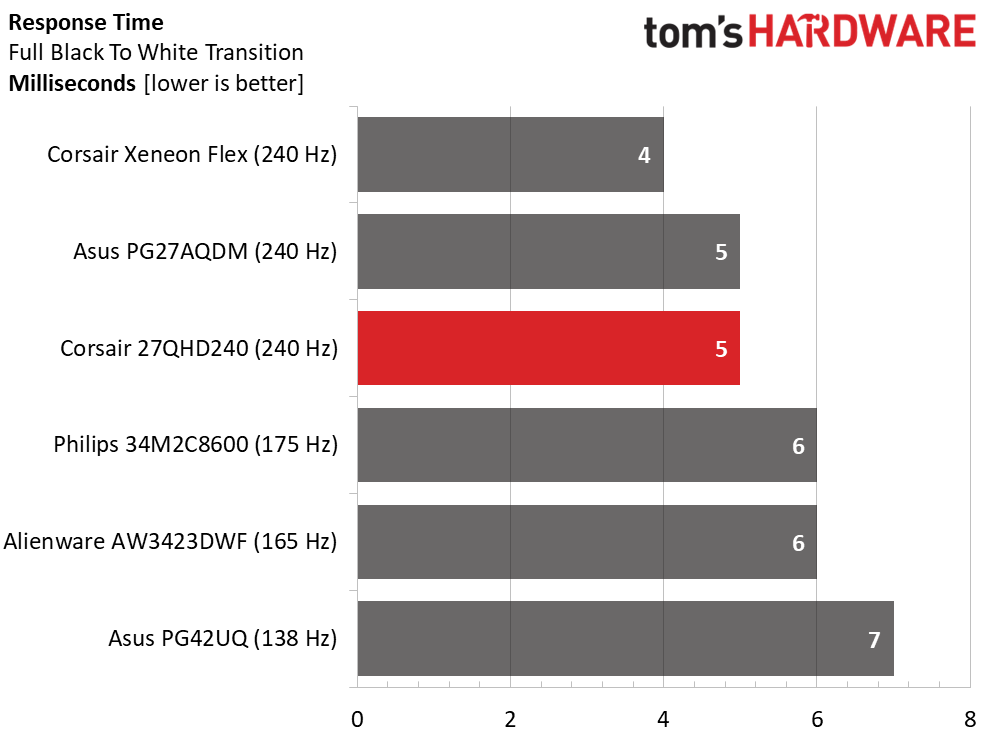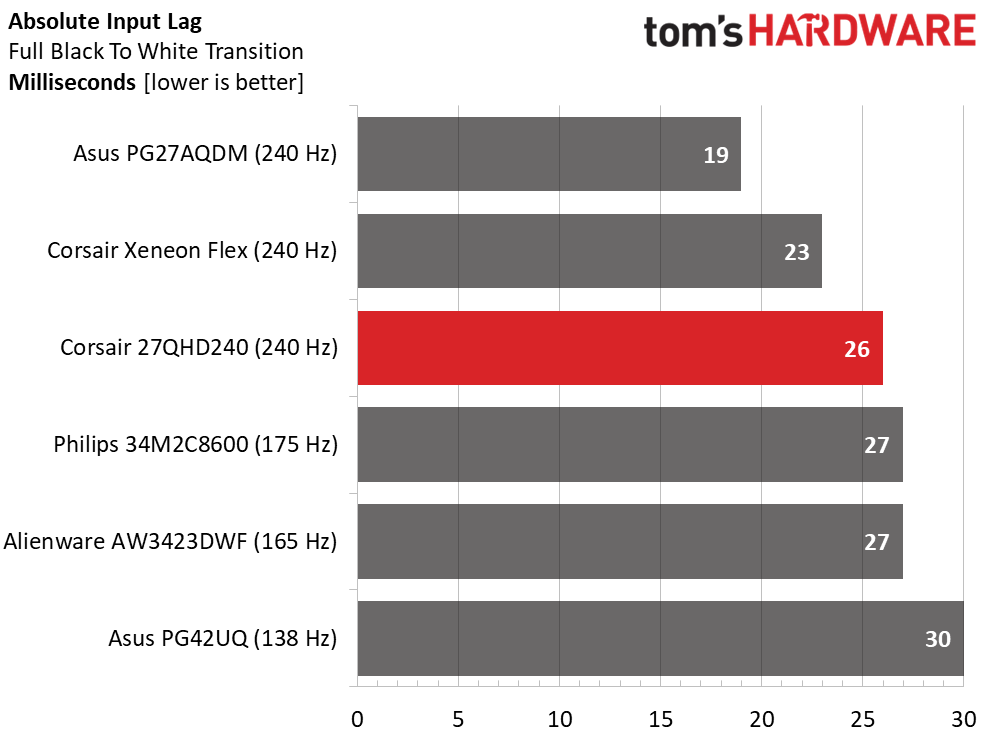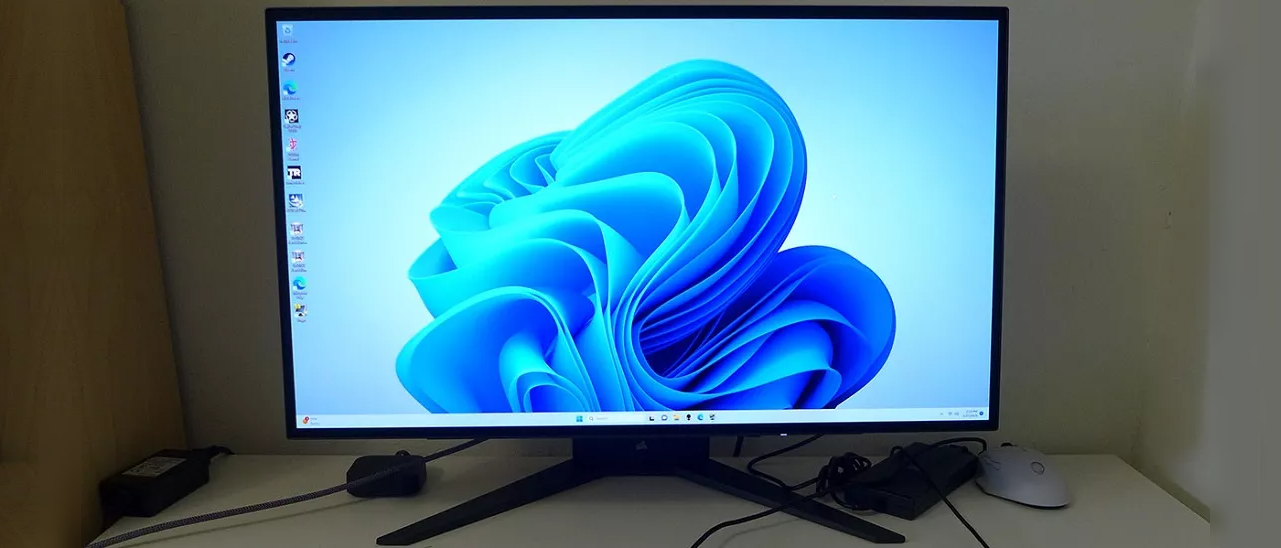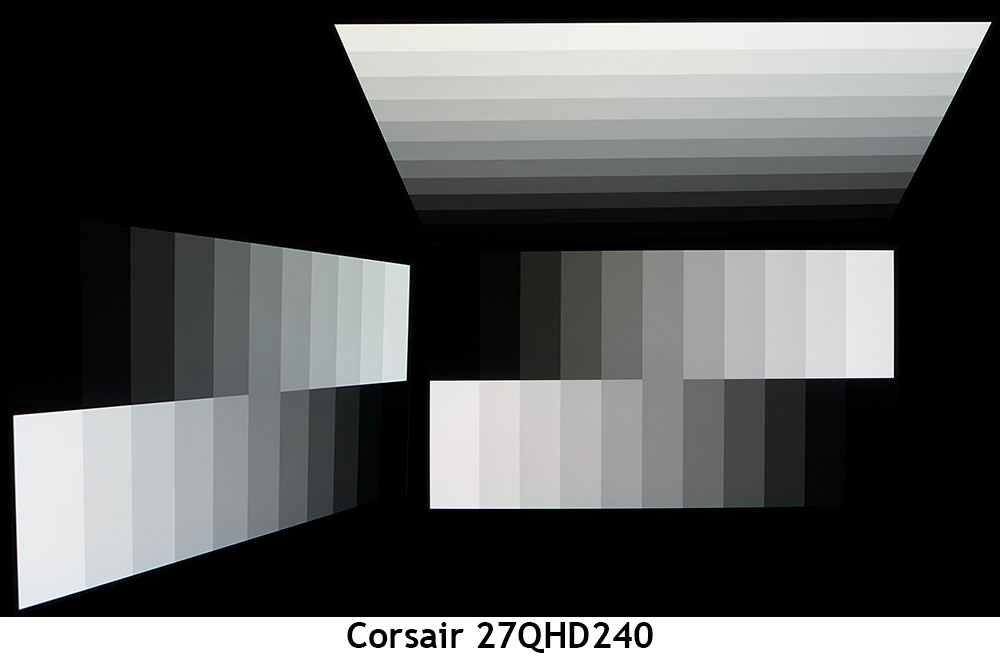Why you can trust Tom's Hardware
Now we get to the fun part; the part where I talk about OLED monitors’ fantastic gaming performance with super low input lag and panel response so fast that there is no loss of motion resolution. I am not exaggerating. All the OLEDs in the 27QHD240’s comparison group offer a similar gaming experience and feel. You will become addicted to any of these screens. In the group are Corsair’s Xeneon Flex, Asus’ PG42UQ and PG27AQDM, Alienware’s AW3423DWF and Philips’ 34M2C8600.
Pixel Response and Input Lag
Click here to read up on our pixel response and input lag testing procedures.


My test is a full-screen black-to-white transition which is slower than the gray-to-gray measurement commonly quoted. 5ms is typical for a 240 Hz panel, whether it’s OLED or LCD. But in practice, the OLED is far smoother. No visible loss of motion resolution exists, no matter how fast objects move or the screen pans. You can see this clearly in Blur Busters test patterns and in real-world content. There is nothing that moves like an OLED.
With 26ms of total input lag, the 27QHD240 is plenty quick enough for gamers of all skill levels. While a 360 or 500 Hz panel will have lower control lag, its motion resolution will be a tad lower. I’m talking about tiny differences here but ones that can be seen with the naked eye.
Viewing Angles
OLED offers the best off-axis image quality of any flat panel technology thanks to grid polarization that is much less aggressive than LCD requires. My 27QHD240 sample showed a slightly cool tint at 45 degrees to the side with no reduction in brightness, nor is there a change in gamma. Detail is fully visible when sitting off-center. The top view is also solid with similar behavior and only a slightly lighter gamma. The 27QHD240 is completely shareable.
Screen Uniformity
To learn how we measure screen uniformity, click here.
No OLED I’ve yet tested has shown any visible screen uniformity issues. The 27QHD240 is one of the best panels, with just 3.55% deviation from center. This is well below the visible threshold. If the worst score is 9.24% from a jumbo 45-inch diagonal panel, that bodes well for the technology as a whole. You won’t see any bleed or glow here.
Get Tom's Hardware's best news and in-depth reviews, straight to your inbox.
MORE: Best Gaming Monitors
MORE: How We Test PC Monitors
MORE: How to Buy a PC Monitor: A 2022 Guide
MORE: How to Choose the Best HDR Monitor
Current page: Response, Input Lag, Viewing Angles and Uniformity
Prev Page Features and Specifications Next Page Brightness and Contrast
Christian Eberle is a Contributing Editor for Tom's Hardware US. He's a veteran reviewer of A/V equipment, specializing in monitors. Christian began his obsession with tech when he built his first PC in 1991, a 286 running DOS 3.0 at a blazing 12MHz. In 2006, he undertook training from the Imaging Science Foundation in video calibration and testing and thus started a passion for precise imaging that persists to this day. He is also a professional musician with a degree from the New England Conservatory as a classical bassoonist which he used to good effect as a performer with the West Point Army Band from 1987 to 2013. He enjoys watching movies and listening to high-end audio in his custom-built home theater and can be seen riding trails near his home on a race-ready ICE VTX recumbent trike. Christian enjoys the endless summer in Florida where he lives with his wife and Chihuahua and plays with orchestras around the state.
-
cknobman Its crazy to think there is a large enough market for a $1000 27 inch monitor to justify products like this.Reply -
hotaru.hino Is the subpixel layout different enough in a way that it produces something off about the image? e.g., like the color fringing on the QD-OLED displays.Reply -
PrazVT Reply
There is. I personally don't have space for a 32" monitor. So 27" monitors are still a thing for me; although I have yet to see a killer 4k mini-led monitor in this size. I will say I wouldn't spend $1000 on a QHD OLED though. Resolution seems low and burn-in risk seems high.cknobman said:Its crazy to think there is a large enough market for a $1000 27 inch monitor to justify products like this. -
PrazVT Reply
Eve / Dough is working on one as well. What is bothering you? The price?Kridian said:Who in the hell's buying these? Corsair, you've lost your mind. -
gg83 Reply
I'm waiting for the $700 27" oled. Maybe something with 144hz or something? I don't know if 240 is baseline for these panels. Seems like once someone besides LG makes oled gaming panels I'll be in luck.cknobman said:Its crazy to think there is a large enough market for a $1000 27 inch monitor to justify products like this. -
bit_user Reply
I'm in the market for a new monitor, and while $1k is more than I want to spend, I'd probably buy one if it were perfect.cknobman said:Its crazy to think there is a large enough market for a $1000 27 inch monitor to justify products like this.
One of the main things putting me off this generation is what I've read elsewhere about the subpixel layout being suboptimal for text. Also, I wouldn't mind getting a couple years' longevity data, to know whether burn-in is still a real issue.
So, instead, I think I'll probably opt for a conventional LCD monitor.
: /
I'm leaning hard towards Asus XG27AQMR, but perhaps I could go with Dell AW2723DF. In either case, I think they're currently a little overpriced, so it'll take one of them getting discounted for me to pull the trigger. -
RodroX Replycknobman said:Its crazy to think there is a large enough market for a $1000 27 inch monitor to justify products like this.
Just as crazy as to buy a $3000 gaming GPU.


